HELLO! I’m Jeanie Phillips and welcome back to vted Reads! We’re kicking off our second season of the podcast with none other than author, professor, associate dean and Vermont education LEGEND, Dr. Penny Bishop.
We’ll talk VT PLPs, the power of a compelling school example in changing classrooms practices, and how to steal all the examples from Personalized Learning in the Middle Grades, with Penny Bishop.
But before we get to the episode I just wanted to say thank you to everyone who’s listened to us so far, everyone who’s sent messages and tweets of support and love. We love you all right back, and are so excited that you want to talk books by Vermont educator, for Vermont educators…
You know the rest.
It’s vted Reads time. Welcome back.
Let’s chat.

Jeanie: I’m Jeanie Phillips and welcome to #VTed Reads. We’re here to talk books for educators, by educators, and with educators. Today I’m with Penny Bishop, and we’ll be talking about Personalized Learning in the Middle Grades: A Guide for Classroom Teachers and School Leaders by Penny Bishop, John Downs, and Katy Farber. Thank you for joining me, Penny.
Penny: My pleasure.
Jeanie: Tell me a little bit about who you are and what you do.
Penny: Well I am a professor and an associate dean at the University of Vermont, and in the College of Education and Social Services. I’m also founding director of the Tarrant Institute for Innovative Education.
Jeanie: Thank you. I’m so delighted to talk to you about this book. I’m going to start with a softball. What book is on your bedside table right now?
Penny: Well, there are probably 12 actually, and there’s a bit of toppling action going on at the moment.The one I’m reading is by Annie Proulx and it’s Barkskins. I don’t know if you’ve read it or not, but it’s an amazing tale of over 300 years. How immigrants came to New France and the landscape, and how landscape and people change over time. I’m really enjoying it.
Jeanie: Oh, I’m so glad. I’ll look forward to talking to you about it when you’re done.
So, let’s talk about this book, Personalized Learning in the Middle Grades. You really start the book, you and John and Katy, by defining personalized learning. I wondered if you could put your definition in a nutshell for us.
Defining “personalized learning”
Penny: Happy to! So, I think the foundation, for me anyway and the foundation for the book, is: believing in the capacity of youth to do great things.
In order to do those great things, we need to enable them, invite them to have more say, more ownership, more agency in what they do and how they learn. The way that we have conceived of personalization in the book is to think about it in terms of three pillars.
The first pillar is knowing students well.
We use a personalized learning plan as a way, as one mechanism, one way to do that, to get to know students well, and then using what we know about students. That first pillar leads to the second, which is flexible pathways or creating authentic opportunities for learning. The third would be a proficiency-based assessments, so valuing what students learn. Using those three things in conjunction is essentially what we talk about in the book.
Jeanie: What I noticed when I was reading through, especially that first portion where you’re defining it so well, is that you take Vermont’s Act 77 and put it in context and into practice in a way that makes it visible for people. You take this abstract concept and really make it visible.
Penny: I feel really fortunate to be working in a state where we have Act 77 because I think it’s given educators license to do a lot of developmentally and culturally responsive work, the kinds of work that teachers know is right, and now we have permission to do it.
So it’s a very exciting time.
Jeanie: One of the tools you use in the book to really take this framework, the three pillars framework and the legislative framework, and make it visible, make it practical, is vignettes. You share stories of personalized learning in action throughout the book. I wanted to just ask where these stories come from because they’re so compelling.
Penny: Thanks. Well, the vignettes that begin the chapters are compilations, so they are not stories of one specific learner but rather they are representations of a number of learners we’ve interacted with across many of our partner schools and across Vermont.
Katy Farber, one of my coauthors, has an amazing ability to bring those stories together. She was the primary author of most of those, but they were the result of the stories that we were bringing from a variety of schools and students.
The personalization and action vignettes that are within chapters, however, are specific to schools and to students and families and educators. In those instances, those are named.
Jeanie: Penny, would you mind sharing one of the chapter beginning vignettes with us, one of your favorites?
Penny: I’d be happy to. I think I’ll read from the very first one, which just tells the story of Miles.
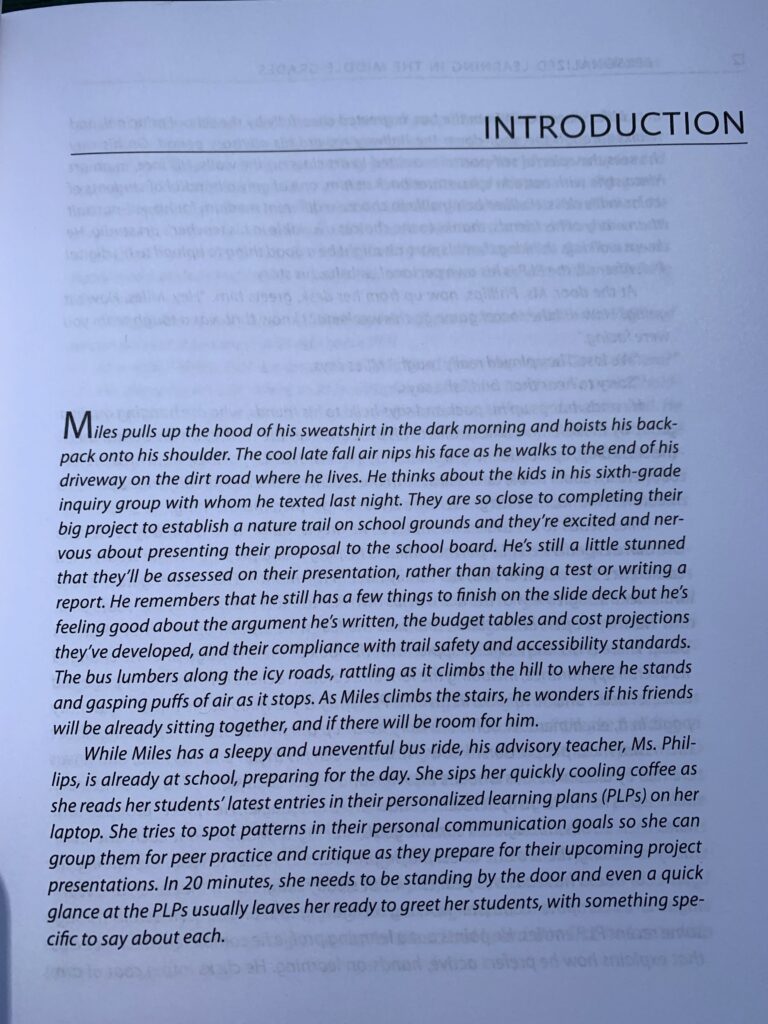
Jeanie: I think Miles’ story goes on doesn’t it?
Penny: It does go on. It’s a long one.
Jeanie: I love it though because it illuminates all of the things you mentioned in your definition of personalized learning. So, in that short vignette, I saw a student agency. I saw how Miles had agency over his own learning. I heard about his flexible pathways. And I saw instances of authentic assessment, where he was going to give a presentation to the school board. All of those things, those terms, those jargony terms we throw around had meaning in that vignette, became really crystal clear to me about how they could look in a classroom.
Penny: I’m glad you enjoyed it. It was a lot of fun. A lot of fun to put together.
Miles is just one of a bunch of composites in the book that I think bring to life the great things that young people are capable of.
Jeanie: Thank you for sharing that, Penny. The way that, in using these vignettes, you’re able to unpack the shifting roles of both students and teachers in a personalized learning environment. You see Ms. Phillip’s role and you see Miles’s role and the other students’ and… it’s different than we think of education from our childhoods, from our own childhoods.
Penny: It’s quite different isn’t it? It’s interesting, I was just doing some writing this morning about this notion that personalized learning may render teachers obsolete. That if you’re looking at things that are highly digital and that sort of version of pace based personalization that so many people equate personalized learning with, that there’s been this backlash around people fighting back against Summit Learning and this idea that we don’t have access to teachers and kids are teaching themselves.
What we’ve found, certainly what’s represented in the book and what we’ve also found in our research, is that teachers are needed more than ever.
That so much of this work is about relationships. So much of it is about helping students find those pathways, scouting out ahead of them for resources if they’re human or digital or otherwise. So yes, we do talk in the book about the fact that when you position students or help them position themselves as drivers of their own learning, it necessarily means new roles for teachers as well.
We’ve conceived of several different roles for teachers in personalized learning environments.
Some of them are similar to roles that teachers already embodied daily, but others are a little bit more unique.
Teacher as Scout
So, for example, when we talk about teacher as scout, we really are talking about, if we’re in a personalized learning setting where students are pursuing, say, 15, 20 different interests in the classroom, how do you stay ahead of students? How do you equip them with enough community mentors? How do you help them find access to the types of curriculum they need? It’s a very different thing than identifying leveled text sets, for example.
Teacher as Scaffolder and Assessor
Similarly, we’ve identified scaffolder or the different types of assessment that teachers are engaged in. The need for even more formative and regular assessment than we’ve done in the past. The importance of building community and so on. So, yes, there are a number of ways that we’re rethinking teacher roles, as well as some teacher dispositions. To have a greater capacity for tolerating a little bit of chaos, for example. Not always having things planned out ahead of time, not having one’s ducks in the row. That’s not always super comfortable for everyone.
Jeanie: I think as a former school librarian and always school librarian, I think that role of scout feels really comfortable to me because a lot of times my role with students K to 12 was to say,
“Well, I don’t know the answer to that, but let’s find out together.”
I love that role because you’re thinking about where each student is heading, or small groups of students are heading, and you’re forecasting ahead, what are they going to need, what resources. The other thing I love about it is that you don’t have to know everything. You just have to know to get them what they need to know. There’s something really interesting to me about that role.
Penny: That’s come out a lot in the research that we’ve done on teacher roles and dispositions. It’s really been about being comfortable with not knowing and being upfront about not knowing. That’s, again, not in everyone’s nature to feel comfortable with that, but it does seem increasingly important to be able to be upfront with kids about it and to say,
“Hey, we’re going to learn this together, and in fact, I might be learning from you.”
That’s a very powerful shift, and it’s an exciting one.
Jeanie: Yes. There’s reciprocity in that. I’m teaching you, you’re teaching me, we’re learning together.
Penny: Absolutely.
Jeanie: Kids love that.
Penny: They really do.
Jeanie: Yes. Do you want to talk about the parallel shifts in student roles that go along with these shifts in teacher roles?
Penny: Yes, thanks. It’s interesting because on page 38, we have a diagram that shows how those things interact between the teacher and the learner.
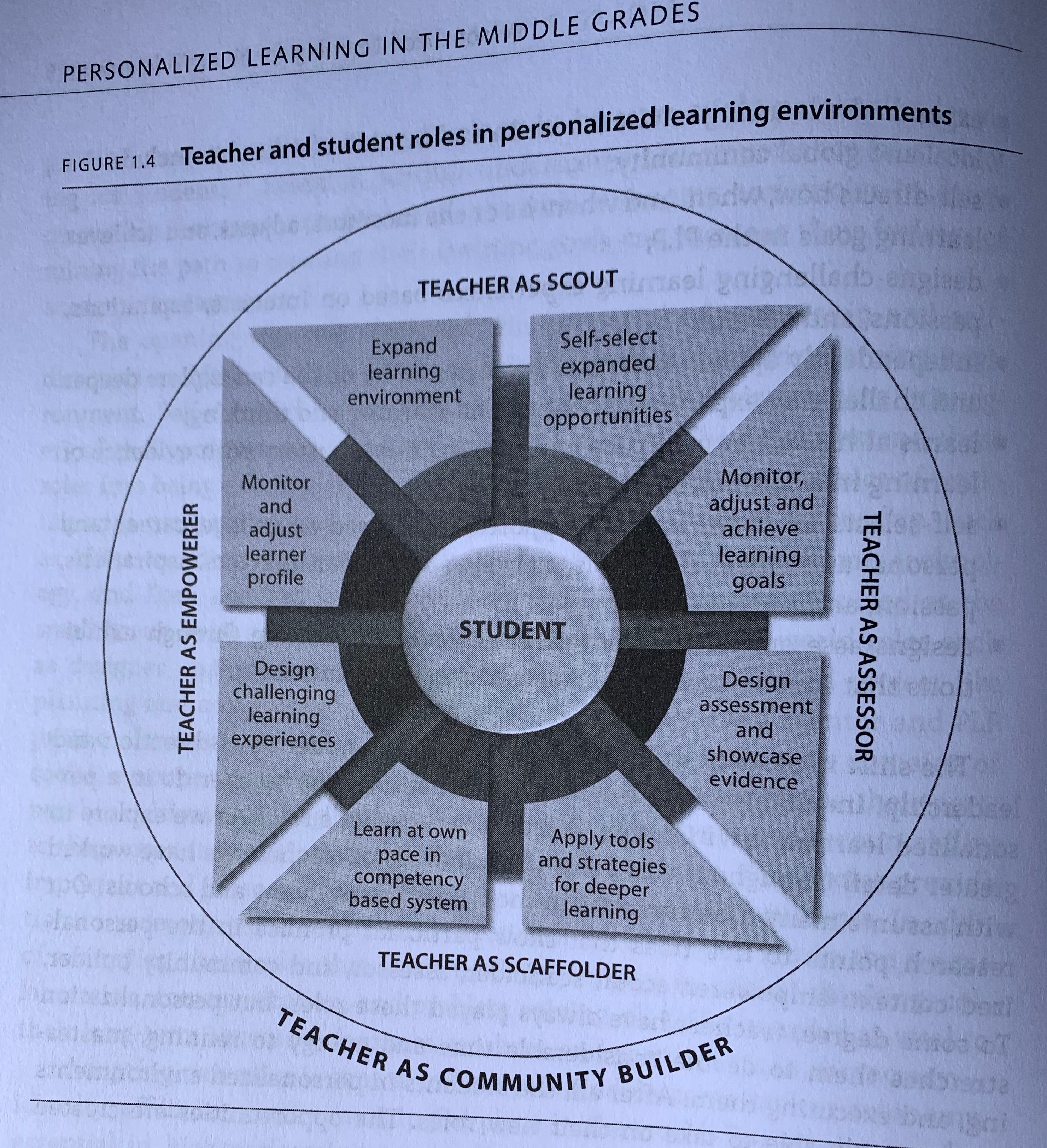
Students as drivers of their learning
Penny: So if you think about the student as now the driver of their education, of their learning, they need to now be doing a number of things they weren’t doing before, or they may have been doing in a number of classrooms. I don’t want to simply dismiss the great things that have been happening in Vermont classrooms for a really long time, because we are very fortunate to be in a state filled with great educators.
But some of the distinctions that we’re seeing are, for example, even this idea of learning at one’s own pace. So needing to be conscious of, as a learner, one, what my pace is, how I manage that pace, how I set goals, how I project manage.
All of those things are more important in a self-directed, kind of personalized learning environment than they have been in a more teacher-directed one.
So those are pieces. *Actually* keeping up with one’s learner profile. So thinking about what’s important for me to know, how do I change over time, how does that change what my goals are? Monitoring that.
Using data is another thing, so helping students have access to their own data and thinking about that data strategically, and what it means for their learning, and how they can move forward. Those are all relatively new roles for a lot of learning environments anyway. Yes, those are a few.
Jeanie: What’s occurring to me as I hear you talk about this and as I read the book too, is often in education we think about various initiatives. We’re always talking about initiative fatigue and how it’s another thing we have to do. One of the beautiful things about this book is that it weaves together these things as a whole and shows you what the big picture looks like where these things aren’t separate things.
Thinking about proficiency, flexible pathways, and PLPs in particular, and how those weave together to form a whole learning experience.
But I’m also thinking about these roles, how it layers in really deeply and meaningfully what we think of as the transferable skills: self-direction and communication being two that feel really important to this work.
And metacognition and reflection. Like if you’re thinking about “who am I now? What’s it mean for me to be a learner?” Those are deeply woven in. Even knowing students well means understanding trauma-informed practice. So, it’s not about separate initiatives, but how we create a cohesive whole to create the educational system our learners deserve.
Penny: *laughs* I really wish you’d written the conclusion because I think that’s exactly it. It’s really about thinking about this work as a cohesive whole.
I think one thing that we’ve learned over time since 2013 when Act 77 was passed, is that we really need to implement it as a whole.
If you take any one piece of this, if you take the PLP, we learned the hard way about the PLP. We talked a little bit about that in the book, that a lot of schools started with PLPs, which seemed like it made really good sense. It was the first deadline, if you will, that came through the legislature: all students have to have PLPs by a certain date, and so we thought: okay, yes. PLPs, goals, let’s do it.
But in fact, if you don’t have flexible pathways, meaningful ways and engaging ways for students to achieve those goals, and then you don’t honor that learning in ways that count, there’s no increased engagement.
There’s no increased learning. So it really is the whole package. It is not a curriculum. It’s not a program. It really is about teaching and learning writ large.
Jeanie: Yes. In many schools that I’m familiar with, PLPs have become a dirty word with both students and teachers because they were implemented without the other two pillars.
Penny: Absolutely. In fact, we’ve seen schools rename or re-label PLPs as something entirely different just to rebrand things.
The Purpose of PLPs
Jeanie: So that takes me to page 52, a page I’ve bookmarked because I plan on using it with some schools as we rethink PLPs. It’s something that I really also appreciate about this book, which is the way that you’ve thought about not just the what, but the why. Do you want to talk a little bit about how you reframed PLPs in terms of their purpose for each stakeholder?
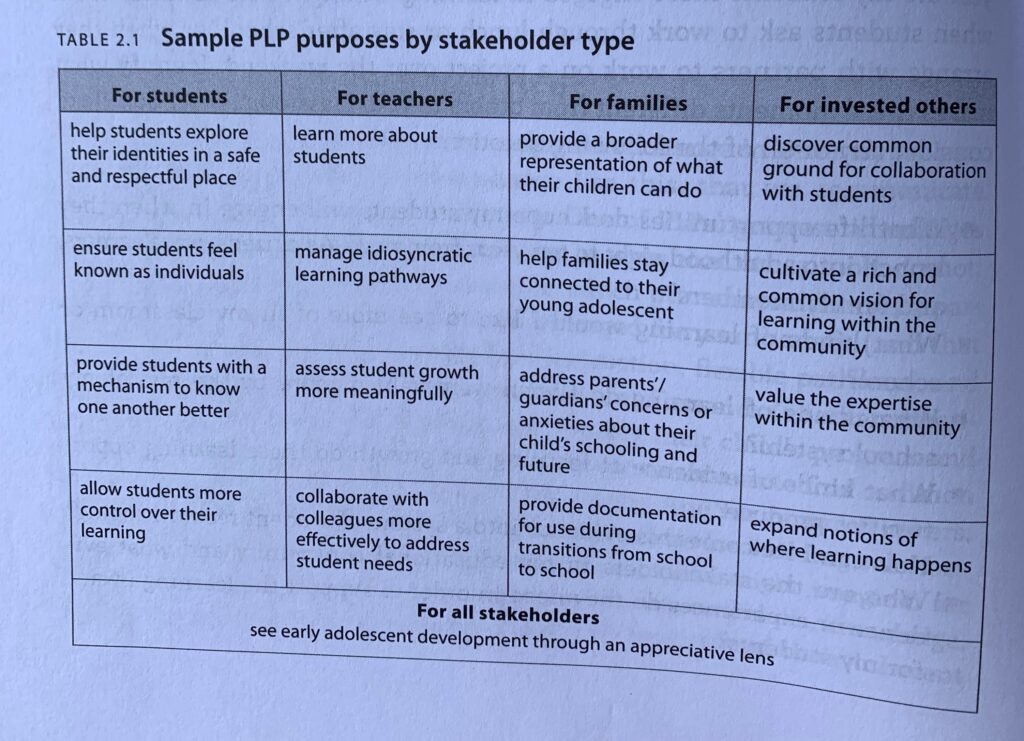
Penny: Sure. I’d love to. I think one of the things that is essential to this work is understanding why we do it. Because you’re right.
We place so many heavy expectations on educators that if we don’t have a clear sense of why, if we don’t have a clear sense of what we’re trying to accomplish, we really do fall into “initiative fatigue”. It’s so easy to see this as one more thing coming down the pike.
So, what we’ve done in this chapter in particular is to focus on purpose and to invite readers to identify their own purposes for the PLP and for adopting personalization.
Move beyond the idea that, “I live in Vermont and it’s mandated here”, or “I live in one of the 39 states where we’re moving in this direction”. It’s: what’s your central purpose? What are you trying to accomplish with this, and for what stakeholders?
So, we talk about in this chapter a little bit about what possible purposes, one might adopt it for for students, for teachers, for families, and then for invested others.
For students, for example, some of the educators we work with identify things like helping students explore their identities in a safe space.
We know that that’s an important work. We ground this book in the middle grades and in early adolescence in particular, although I do think that a lot of it is pertinent well beyond the 10 to 15-year-old. But we do know that in particular, adolescents are all about identity development and it’s a great space for that.
Other purposes include ensuring that students are well known as individuals. Or providing them with greater control over their own learning.
For teachers, they serve a number of purposes including giving them a way to manage all those idiosyncratic pathways, all these flexible pathways that students are now pursuing.
How are we documenting those? How are we keeping track of them? Also assessing a student growth? How do we do that in a meaningful way?
For families, we’ve found that they are really powerful particularly when coupled with student-led conferences.
They convey both that adolescent identity, but also growth over time, best work, what really powerful portfolios can do in a way that is even more driven by the student and can help families be even more connected to adolescents at a time when adolescents are starting to pull away.
So that’s an exciting opportunity for families maybe to learn a little bit more about their own child.
We included this other category called “invested others” because as learning becomes more personalized, and as we do find teachers acting as scouts and engaging community more in mentoring young people, we find that that category is broader and broader.
It really does take a village. So, invested others may be community members who are mentoring in this school or allowing a job shadow or simply being an online support in some way.
Community could be quite broadly defined, so it could be folks who are across the globe or it could be people in one’s own town. Purposes for them might be to discover common ground for collaboration with students as well as to convey a sense of respect for the value in the community and the knowledge of the community.
It also helps for all of us to expand notions of where learning happens.
I think across all of those stakeholders, a central purpose is also to see adolescence through an appreciative lens, which we so often adopt a deficit lens. So, that’s a big one for me.
Jeanie: Oh gosh. I have so much to say right now. There are two directions I want to take this.
I’m going to start by thinking about how I love this “invested others” category because it creates avenues for authenticity in the student work.
One of my passions is creating work that’s real for kids. Right now I’m thinking about the kids at Edmunds who did some social justice work, and there are a couple of girls who really focused on the pink tax and they have connected with the legislature and in really powerful ways with lawmakers.
We love hearing about young Vermonters who are civically engaged! Middle-school students in VT started this petition to urge the Vermont Legislature to support tax-free feminine hygiene products #Vermont #VT #TamponTax #PinkTax #VTPoli https://t.co/cmXIJOpokX
— VT Commission on Women (@VTWomen) June 3, 2019
So, thinking about what a powerful learning experience that is for them, and also how grateful I am to them as a woman in this state for getting this important message out and making change happen. This kind of PLP leverages authenticity and meaningful work for kids.
Penny: I think that’s right where the engagement resides. It’s in that meaningful work on matters of personal and social significance. That’s the engagement right there. That’s what makes all the difference.
Jeanie: That’s the learning you remember. Those are the powerful moments that really stick with you.
Penny: Absolutely.
Jeanie: Then the other side of this is:
I’ve been thinking a lot about how we are often trying to shift practice — classroom practice, school practice, teacher practice, and student practice, without shifting belief.
I think that’s where initiative fatigue comes in too. Do this new thing, administer this test. But there’s no why behind it. So, I also love that this asks us to think about belief. What do we really believe about teaching and learning, and how does that belief shift into this PLP to make it meaningful?
Penny: And what do we believe about the purpose of schools?
Jeanie: Yes. I just really appreciate the thought that goes into both sides of that. The, “Why are we doing this anyway?” Let’s spend some time on that so that the practice makes sense and we invest ourselves in it because it has something to back it up.
Penny: I agree.
Jeanie: Props for that to you guys.
Penny: Thanks. Thank you.
Jeanie: I can already see the countless ways that I’m going to use this book, but what’s your hope for how Vermont educators are going to use this book?
Penny: Well, I think first and foremost, I hope that they see the great capacity in youth. What I mentioned earlier. Students are capable of so much.
I think the pink tax work is a great example of that, that our youth are capable of real work with real outcomes, powerful work. There are so many examples of that in the book, not just from the composites but from actual teachers and students working together in really authentic ways.
I hope if nothing else, it’s inspirational in that regard because it really is the product of so many students and educators working together and working really, really hard. I hope that it may give them some clear strategies. We tried to make it as useful as possible.
Teachers are busy and it’s definitely written for the teacher audience, so we tried to make it accessible and inspirational. Each chapter provides both personalization and practice, which gives little examples of what it’s looking like, but also some ideas that people could even just steal, and put into practice the next day. I’m hopeful that it’s useful in that way as well.
I’m hoping that it will serve as a conversation starter, because it was just our best thinking at that time, and it’s been out for a few months, and certainly it’s been done for probably a year. So, it takes a while for it to come out, and so now we’re already into another place in terms of how we are imagining what the potential can be.
I’m hoping that teachers and students will help us move it forward.
So, a conversation starter.
Jeanie: Yes, I totally see the practical strategies. The two chapters that really hit home for me in terms of the like, “Oh, I could take this and run with it,” are the Laying the Groundwork for Personalized Learning chapter, about building that community. That’s a lot about teaching the skills that students need in order to be agents of their own learning, to be drivers of their own learning. I just love the Launching PLPs with the Learner Profile. You have such rich examples from excellent Vermont educators around the state and what they’re doing in practice in that chapter.
Penny: Well, it’s funny that you mentioned those two because for me, yes, chapter three that sort of sets up some infrastructure is I think a helpful one. Then the Laying the Groundwork piece.
Often we expect students to know how to be self-directed. We expect our classroom culture to support it without ever really attending to it.
So really thinking about: what is the executive functioning? How do we interact as a community? All of those pieces really need to be in place to see it done well and to help students be successful. I think if we don’t attend to those things, we risk setting them up for failure as well as ourselves. I think those pieces are really important.
Then I love that you brought up the examples that are about knowing students well, because one of my favorites there, actually, there are so many great ones. But Lori Lisai and Joseph Murphy from Lamoille Union Middle, have this incredible set of activities called the Geography of Self.
I just love so many of the things. One of them is an autobiographical map. I just love the idea of being cartographers of one’s own life.
There are so many rich examples like that. That’s just one small one, but I just found them so engaging. If I were in the classroom, those are a number of the ones that I’d want to steal right away.
Jeanie: I love those Geography of Self examples. I love the iceberg activity that happens at Tuttle.
Using the iceberg model of culture to discuss differences between gender expression and gender identity today (among many other aspects of self/culture/identity). Our Ss are rockin' it!
— Christie Nold (@ChristieNold) December 5, 2018
There are so many great examples in there. Then another thing that I noticed that I just… I remember seeing it on the wall when I visited there is, at Williston they use these great handouts for executive functioning skills that really lay out exactly what it looks like to be self-directed in ways that helped me as an adult.
I know these were designed for middle school kids, but I’m like, “Oh, that’s how I get started.”
Penny: Well, it helps give you language to talk about it. Right? Yes. I find all of those examples were terrific.
Jeanie: So this book, it’s really written for teachers, but I feel like it also has relevance to systems-level leaders.
I’m wondering about how you see it being used for systems change.
Penny: Well, that’s a great question. Our hope is that it will inform both that daily practice in the classroom, in and out of the classroom. We hope that a lot. But it also has implications for systems, both at the school and the district level. The supervisory union level.
I think one of the pieces that I hope people find helpful is this idea of some guiding questions. It gets back to the why are we doing it idea, but it gets even more pragmatic. I think on page 75, we offer some guiding questions for PLP design teams.
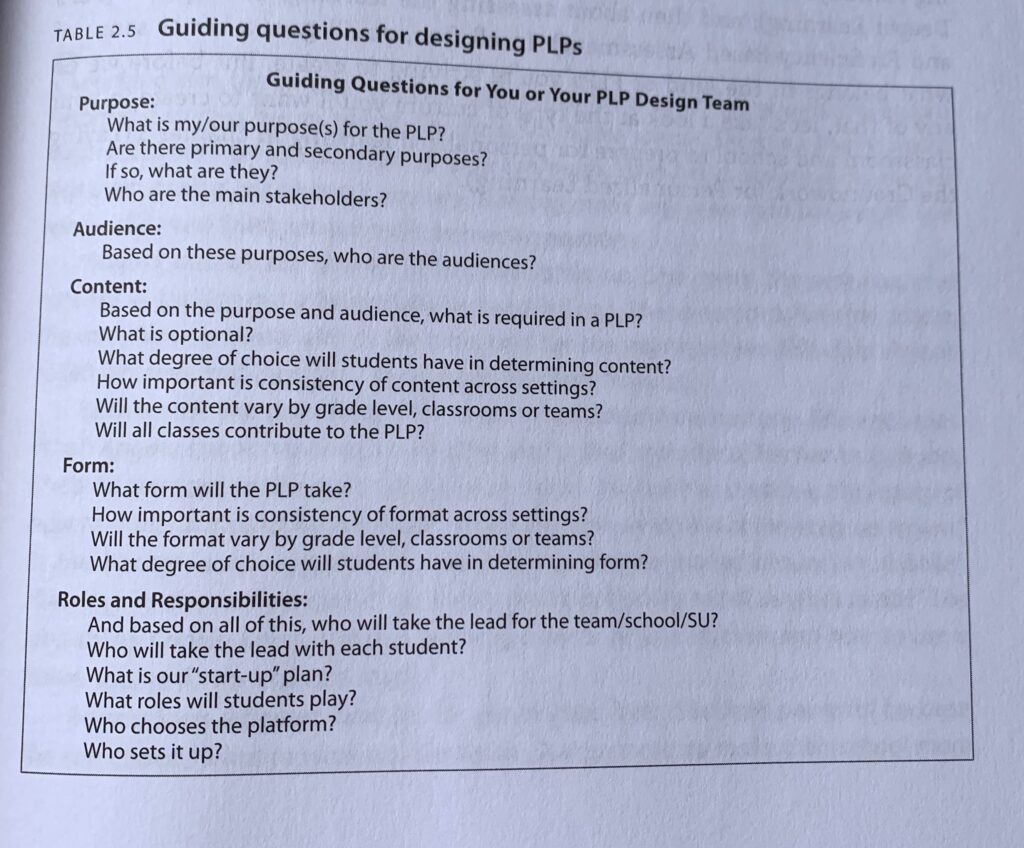
I think it depends on where that design is happening, but I know a lot of schools are doing that at the school or district level. We pose questions for folks to think about in terms of their purpose and their audience, and how those two things need to drive the content and the form.
Then how really explicit conversations need to be had about roles and responsibilities in relation to all of those things.
So, when we asked teachers before we wrote the book, “What would you like to see in a book about personalized learning, and in particular PLPs?” They answered with questions like:
- What’s the purpose?
- Who is the audience?
- What should go in it?
- What are the required contents?
- Will all classes contribute to the PLP?
- What platform will we use?
We quickly realized that it would be a very short book if we answered these questions because our book would basically be, “…It depends.”
It depends on your classroom, team, school, district, and supervisory union. Whatever your unit is, that asks and answers those questions, doesn’t it? So, those are precisely the questions to be asked, and they do inform systemic change.
My hope is that by offering some of that, we can inform infrastructure in a way that helps people find a path toward coming up with some common language and a common vision.
Jeanie: I’ve been thinking a lot about how one of the things that gets in our way as we try to reform schools or think differently about schools is a failure of imagination.
It’s hard to imagine school different than how you went to school.
It seems to me that this book fills the gap that is left by a lack of imagination in helping not just teacher see how it could look different.
Because I think teachers know how it could look differently, but administrators and school board members and other stakeholders for whom they might say, yes, we want personalized learning, but then walk in the classroom and expect the classroom to look the same.
I love this one vignette where the principal walks into the classroom and can’t see the teacher and he looks around and the kids are all doing different things.
There’s this moment in the vignette where the principal thinks, well, I know the teacher’s in here somewhere. And then he finally spots the teacher sitting on the floor in the corner working with one student. It reminds me that, as somebody who likes order, that when I’m in a classroom that’s really personalized, I always have to take a deep breath and think, “Okay, look around, what’s really happening. Yes, it’s noisy. It feels a little chaotic, but what’s really happening? Everyone’s actually on task and doing something. I’m the only one that’s uncomfortable.” I think administrators have to figure that out.
Penny: Yes. They’re not the only ones who have to figure it out, but they absolutely do. In fact, when we were speaking earlier about roles and dispositions, and I said, sometimes you have to be a little comfortable at chaos, usually it’s not chaos.
It just looks like chaos because it’s not form and order and things that we come to associate with what learning should look like, quiet compliance as opposed to active learning.
So, I agree. I appreciate that you picked up on, it’s the book’s ability to convey what could be, that idea of imagination, because that certainly was a goal. In fact, it hit home for me a few months ago when our state legislature was grappling with some pushback on proficiency-based assessment and the proficiency-based graduation requirements. Maine as a state had those, and those were… they were moved from mandated to optional.
At that same time, in Vermont there was some pushback. So, the House Ed Committee invited me to come in and testify on those. What I quickly realized as we were having a conversation in that space is that so many people just couldn’t see it.
It’s that gap between our own experience in our education and what’s happening in today’s world. We needed more examples and stories of what it looks like and what it can be.
So it is, I appreciate your putting it into the words around a failure of imagination. Or maybe the bright spark of imagination because I am hopeful that it’ll do that.
Jeanie: My understanding of Maine is that one of the findings is that while the graduation requirements changed, in places where classroom instructional practice didn’t change, things didn’t work out so well. (.pdf)
And what this book does for me is it really demonstrates how classroom practice changes.
How the mechanics of what happens for learners in the classroom is vastly different than a stand and deliver a teaching method.
Penny: I think it builds on this notion that the three pillars need to be enacted together. As opposed to really highlighting well, if we only do proficiency-based assessment, then yes, we are going to see pushback because nothing else is changing.
Jeanie: Yes. So do you imagine that this book could play a part of Vermont Education Policy? Do you think that this book could foster conversations that would help the legislature as they navigate Vermont Education Policy?
Penny: I absolutely do. I think that had it been published back when I was testifying [to the legislature about Act 77], it would have been a really useful thing actually to give to House Members. Because it not only imagines what’s possible, but it also shows what’s happening in Vermont schools right now.
I think that’s one of the things that’s most exciting to me, it is the stories of real kids and real educators working really hard on this work and doing inspiring work.
Jeanie: How do you see it as a part of a more national conversation?
Penny: Well, right now if you were to examine Every Student Succeeds Act educational plans, which every state had to file, 39 of them referenced personalized learning in some way as a priority in the vision to some extent. So, it’s very much part of the national conversation right now.
Accompanying that is this focus on competency-based, or what we call proficiency-based here in Vermont, assessment as well. So, it’s very much part of that national conversation. My colleagues and I here at the University of Vermont and at the Tarrant Institute certainly do a lot of national presentations and we write for a national and international audience, so I know that we are informing those venues. I know that a lot of people in the US are looking at Vermont right now.
We have one of the most comprehensive policies in place for personalized learning, and so we’re kind of on a national stage and with Maine having folded back on their proficiency-based graduation requirements.
People are looking at Vermont to see what’s going to happen next, and so I’m really hopeful that these stories will show what’s possible.
Jeanie: Yes, I hope so too. Have you gotten any feedback on the book from educational leaders or practitioners yet?
Penny: We have, actually. I’m delighted to say that we’ve gotten some really great feedback. It seems to be being received well, so I’m optimistic about that. We’ve had a number of folks shoot us emails to say, “Wow, it’s really great. Thanks so much. This is helpful. I’m going to use it in this way or I’m going to use it as a whole school read next year for our faculty. I’m having folks use it in this way.” So we’ve definitely gotten some nice reviews and some emails, so thanks for asking about that.
Jeanie: I do wish I had a time machine and that we could shoot this book back to when I started my job here at the Tarrant Institute! It certainly would’ve been helpful for me. And it also feels like really personal because it celebrates Vermont schools, and you’ve referenced that many times.
It feels like a real celebration of teaching and learning in Vermont.
As I read through the book, I just delighted in the number of teachers who get a shout out for their hard work, the number of students featured, the presence of both student and teacher voices. Do you have any messages for the Vermont Education Community?
Penny: Yes, a few. There are a lot of shout outs, and there were so many more shout outs we could’ve given.
So that’s sort of a hard thing is that there’s a page limit. Turns out, they won’t let you publish a thousand-page book! We have thousands of pages worth of great stories in Vermont to tell.
I also would like to say that we sent a copy of the book to all schools that have grades five through eight, or students ages 10 to 14 or 15 across the state.
If you’re listening to this, there’s a really good chance that there’s a copy kicking around your school right now.
(Ask your principal about it.)
The final message I would want to say is that, as you know, Jeanie, we do present nationally a fair amount. So, we talk a lot with educators from other states. Inevitably, when I come back to Vermont after having gone to national conferences, I come back with a renewed appreciation for the depth of care and sensitivity and dedication that our educators have for this work and for our youth.
We are so fortunate to be in Vermont, and Vermont educators are doing incredible work.
I just feel really lucky to be here. Sometimes I think people don’t always get a chance to leave and then come back to appreciate anew what a great education system we have here. I just kind of wanted to name that.
Jeanie: Well, I just want to name that the book feels much like when we talked about the reciprocity between the teacher roles and the student roles. This book feels like a gift of reciprocity. It feels like you all and we all as the Tarrant Institute learn so much from our partners in Vermont schools. From the partner educators we work with. From the students at those schools. And from the conversations we get to have with Vermont teachers and educators across the state.
You wove that learning and created something new out of it that teachers can then learn from. There’s something about the way that you synthesize all those experiences into this rich work that everybody can learn something new from. I just have deep appreciation for. Yet you still are constantly giving shout outs to all these great schools and teachers and students.
Penny:
Hopefully, it shows a bit of the enormous gratitude we feel toward educators and students because they’ve given us a ton.
Jeanie: Yes. Any other thoughts, Penny, about Personalized Learning in the Middle Grades?
Penny: Well, I’d just like to thank you for inviting me to talk with you today. I really have enjoyed it.
Jeanie: It’s a pleasure. It’s always a pleasure to talk to you, Penny Bishop.
I’m Jeanie Phillips and this has been an episode of #vted Reads, talking about what Vermont educators and students are reading. Thank you so much to Penny Bishop for appearing on the show, and talking with me about Personalized Learning in the Middle Grades. If you’re looking for a copy of Personalized Learning in the Middle Grades, check your school or your local library.
To find out more about #vted Reads, including past episodes, upcoming guests and reads, and a whole lot more, you can visit vtedreads.tarrantinstitute.org. Follow us on Twitter and Instagram at @vtedreads. This podcast is a project of the Tarrant Institute for Innovative Education at the University of Vermont.


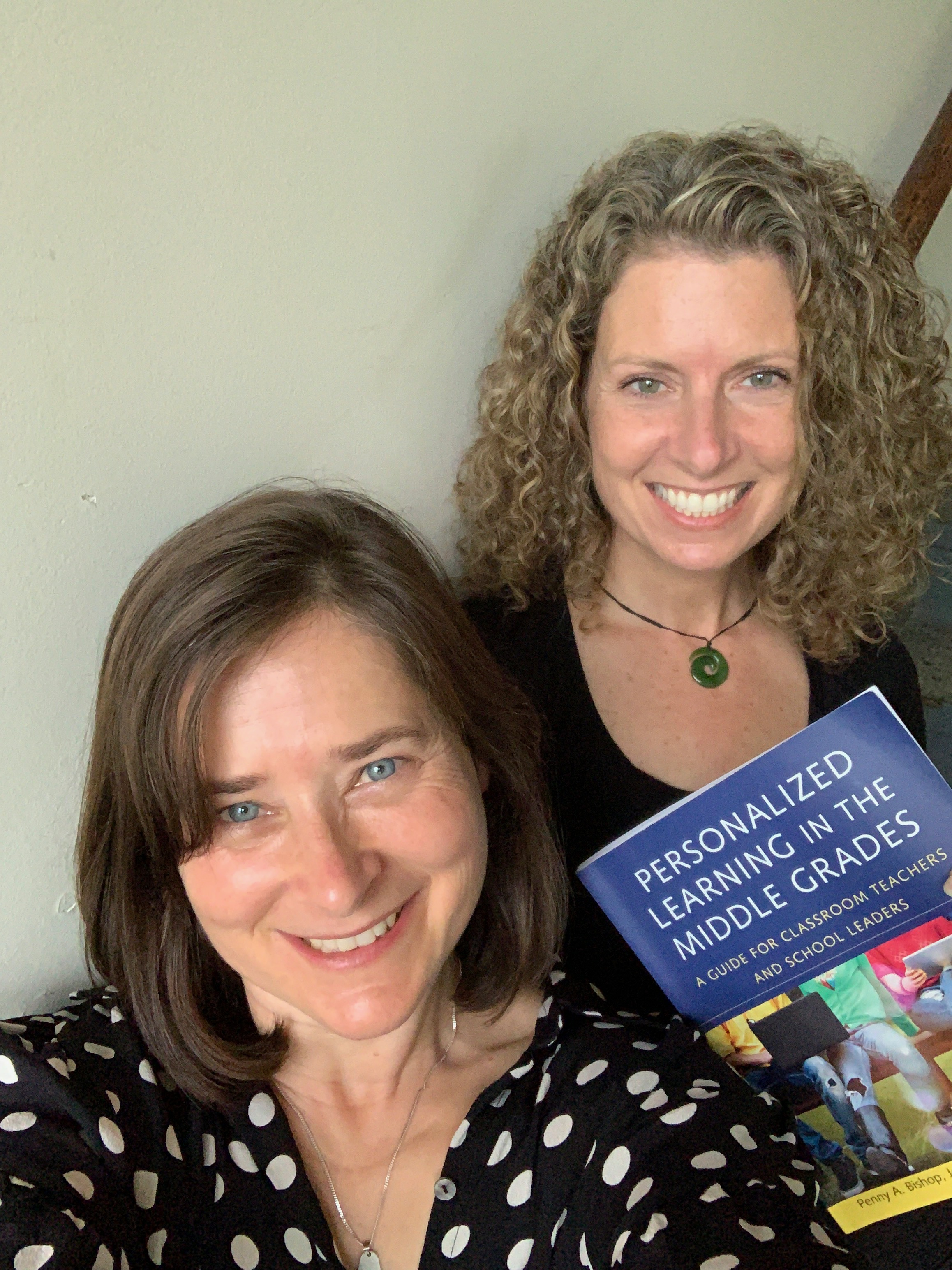
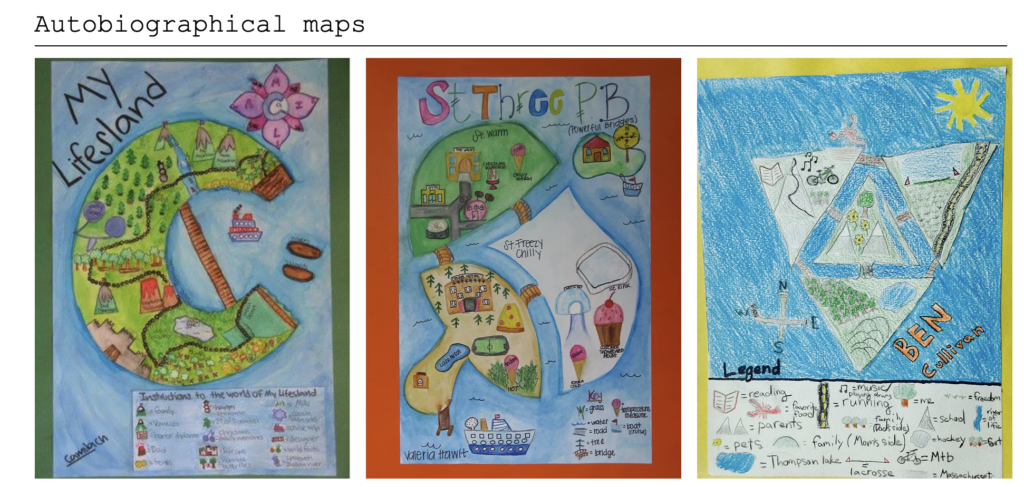
thanks for post.